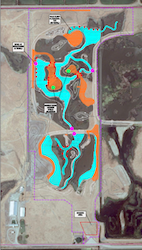Keeping the Conservancy’s managed marsh complexes fully functional is a requirement of the 2003 NBHCP. As the Conservancy’s marsh and wetland areas fill in over time from eutrophication, particulate deposition, fossorial animal diggings, etc., they eventually fill in and ultimately become uplands. When that happens, the aquatic species the Conservancy is charged with protecting have no refuge or sanctuary.
The Conservancy and its contractors have been attempting to conduct this channel-clearing maintenance work in the least amount of time practical during its annual summer maintenance operations. The longer the marsh complexes are out of service, the longer the Covered Species that depend on them are unable to use them. Last year’s Phase 1 BKS North Course Channel Maintenance Project was completed in 22 business days. This year, on Phase 2, the work was done in 17 days! A total of 36,209 cubic yards of soil were moved, dozens of tule and soft rush plants relocated, and biological monitoring and maintenance access was enhanced. So as of today, BKS tract ponds “M” and “N” (Phase 2) are back in service as functioning managed marsh habitat. Conservancy officials have already spotted giant garter snakes in them.
The Conservancy now begins work with its consultants and contractors to plan for the BKS North Course Channel Maintenance Project, Phase 3. This work is scheduled for the summer of 2013. It involves just one large pond, BKS Pond Q. It is one of the Conservancy’s largest ponds, and has a number of challenges to it, so it will likely take longer to complete. After renovation of the BKS Pond R is completed in 2014, all of the Conservancy’s flagship marsh complexes on the BKS tract will have cycled through their maintenance service. The Conservancy expects that the the next service interval will be in 10 to 15 years.

